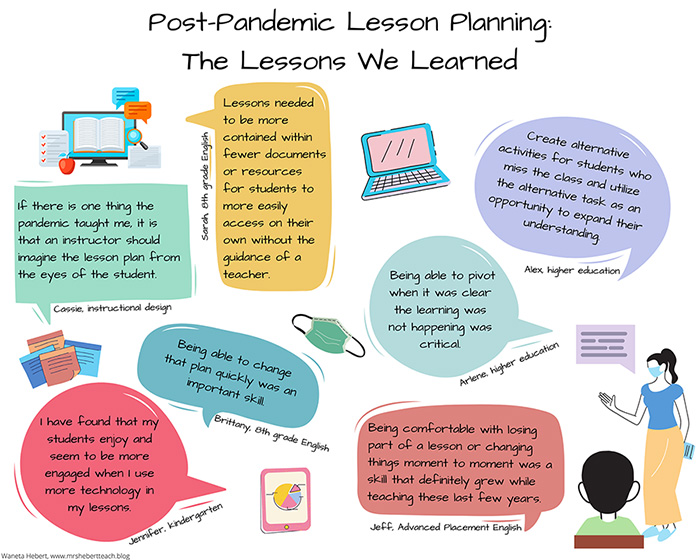This month marks two years since the start of the chaos that was, and still is, the COVID-19 pandemic. I remember back in February and early March of 2020 when my eighth graders cracked jokes about someone “taking one for the team” and catching the coronavirus so that the school could close for two weeks. I wonder now if those students remember making those jokes. We had no idea then what lay ahead of us.
The field of education faced challenges unlike anything we had experienced before. It has laid bare the failures of the entire education system, but also highlighted the innovative nature of the field. I’ve actually reflected on all of this before, during that first remote semester and then again last summer. Now that we’re hitting the two-year anniversary, I find myself thinking about all of those lessons learned once again. Most schools are “back to normal” with students and teachers in classrooms again, many with masks but still many others without. My own personal journey sent me back into the classroom for a bastardized version of hybrid teaching for several months before I traded my classroom for my home office and a new career path. Now, as an instructional designer, I’m still working from home due to the never-ending pandemic, with the ever-present possibility of suddenly returning to an office I’ve barely seen.
In my reflections today, I thought that instead of just writing about my own experiences again, this time I’d collect lessons learned from others and compile them here for you, my intrepid readers. I called on my friends and network of educators with a simple two-part question: “What did you learn about lesson planning during the pandemic? What did you change about the way that you lesson plan following the pandemic?”

I received several knowledgeable and insightful answers. Responses came from a kindergarten teacher who taught before, during, and is still teaching after the pandemic; an eighth grade English teacher who was lucky enough to be a first-year teacher during the infamous 2019–2020 school year; another eighth grade English teacher who left the classroom not long after I did; and a high school English teacher who also happens to be my husband. I also pulled in several voices to provide perspectives from higher education, including a couple of higher education instructors and an instructional designer.
Here’s what they said.
Table of Contents
Flexibility & Adaptability
Two words I saw across nearly every response were flexible and adaptable. At the height of emergency remote teaching, instructors rarely knew what was going to happen next, with changes that seemed to happen on an hourly basis. Education was in a constant state of flux, even more so than what educators were used to before the pandemic. Educators have always needed to be able to make on-the-spot decisions to change or adapt a lesson to meet the needs of the learners in front of them, but the pandemic put this skill to the ultimate test.
As has always been the case, these decisions are made for the benefit of students. Cassie (instructional designer) shared that “If there is one thing the pandemic taught me, it is that an instructor should imagine the lesson plan from the eyes of the student,” and Arlene (higher education) mentioned that “Being able to pivot when it was clear the learning was not happening was critical.”
Some of this need for flexibility came in large part due to the online format of emergency remote teaching, especially during the Spring 2020 semester. Jeff (Advanced Placement English) talked about making changes to adjust for the online modality: “No matter how well I thought I had designed a lesson, some things just didn’t land when teaching online.” Arlene agreed: “During the pandemic, what worked in the traditional classroom did not always translate well to remote learning.”
One thing that I have harped on a lot over the past two years has been the difference between emergency remote teaching and true online learning. As Arlene put it, “When teaching remote or online in the past, the students chose that modality; during the pandemic it was forced upon them.” Not all students are suited to online learning, and instructors had to take that in consideration when designing lessons. Some lessons needed to be adapted to be taught online, and others had to be adapted for students who were struggling with the modality as much as with the content.
A common sight in online classes was the Zoom gallery view of blank boxes, and instructors didn’t necessarily know how many students were really with them, how many logged in for credit and walked away, or how many were present but struggling silently. Brittany (eighth grade English) reflected, “There would be times that I had to adjust my lessons for certain classes because of missing students or a large gap in understanding, and being able to change that plan quickly was an important skill.” Similarly, Jennifer (kindergarten) said, “On most days, the plan had to be cut back or changed based on the amount of students that attended or the amount of focus the students had at our online meetings.”
Sarah (eighth grade English) mentioned that her pandemic lessons were “more condensed down to the ‘essential’ skills I wanted students to practice.” With the overwhelming nature of the pandemic, it was often necessary to cut a lesson down to just the heart of what the students needed, and Jeff mentioned still “being comfortable with losing part of a lesson” even now that his school is back to “normal.”
Moving beyond the pandemic, flexibility will continue to be an important part of lesson planning. Brittany put it perfectly when she said, “I think this skill is actually relevant regardless of the pandemic, just given our current state of education, and I am continuing to learn how to adapt on my feet.”
Looking for professional development resources? Check out the Infobase Learning Cloud.
A Bit More on Technology
We can’t talk about pandemic lesson planning without talking extensively about technology. The move to emergency remote teaching forced everyone to set aside their reservations and adopt educational technologies that they may not have wanted to use before. Those of us who had been using educational technology before the pandemic already knew how technology can cause as many problems as it solves. Cassie pointed out that “you should consider what roadblocks and incidents may come students’ way. This is especially true for technology, which is why lesson plans during the pandemic must also include contingency plans and clear instructions for moving forward.”
With the online modality, students were forced to be independent learners in a way they may not have in the past. Instructors leveraged technology to help students navigate online learning environments. Sarah reflected, “Lessons needed to be more contained within fewer documents or resources for students to more easily access on their own without the guidance of a teacher.”
Technology also helped with those empty Zoom boxes by engaging students in fun, content-based activities. Jennifer described how technology engages her kindergarten students even post-COVID-19: “Something I did change following the pandemic is using more technology-based teaching in my lesson plans. I have found that my students enjoy and seem to be more engaged when I use more technology in my lessons (online read alouds, songs, videos, seesaw activities, etc.).”
Multiple Options (a.k.a., The UDL Plus-One Approach)
I recently finished reading an incredible book about Universal Design for Learning (UDL) in higher education.
Reach Everyone, Teach Everyone by Thomas J. Tobin and Kirsten T. Behling is a guidebook for starting and maintaining a UDL initiative on a higher education campus. If you’re not familiar with UDL, I suggest spending some time on the CAST website and exploring the guidelines, but my ten-cent summary is that UDL is about removing barriers to learning to make learning accessible for all students. Tobin and Behling suggest the Plus-One Approach, in which instructors can find the pinch points in a course that are causing problems for students and provide one alternative choice for the presentation of information to students or in the activities and assessments where students demonstrate their mastery of content.
I mention this book here because this idea of providing alternative options for students was another theme I identified in the responses to my questions. In talking about his lesson planning post-pandemic, Jeff said, “I might have multiple options for how to approach an objective or an assignment, or I might develop alternate assignments that ultimately become retake opportunities.” Alex (higher education) also talked about providing multiple options: “Create alternative activities for students who miss the class and utilize the alternative task as an opportunity to expand their understanding.”
Arlene’s response provides a good summation for this section: “Post-pandemic, my lesson plans are more varied, more visual, more examples, and include multiple modalities. Even when the teaching is in-person, there are other options provided to the students like readings, videos, and notes like those provided during the pandemic. Overall I have become more inclusive in my offerings now than pre-COVID-19.”
Moving Forward
As we continue to move into this strange post-COVID-19 space, I’m sure we’ll continue to learn from our experiences. Teachers are at heart always learners. Before the word “pandemic” became a part of our daily vocabulary, teachers were already learning from each flopped lesson plan and each student success story.
If you haven’t already, I encourage you to take a few moments to think about your own lessons learned from the pandemic. What did you learn about lesson planning during the pandemic? What did you change about the way that you lesson plan following the pandemic?
See also:




